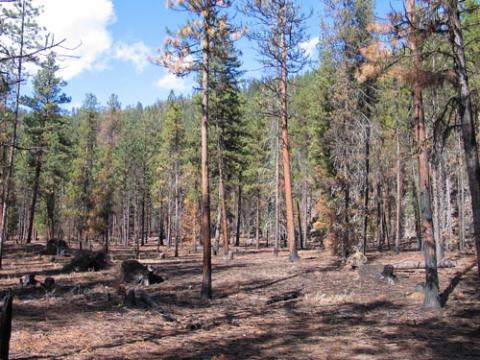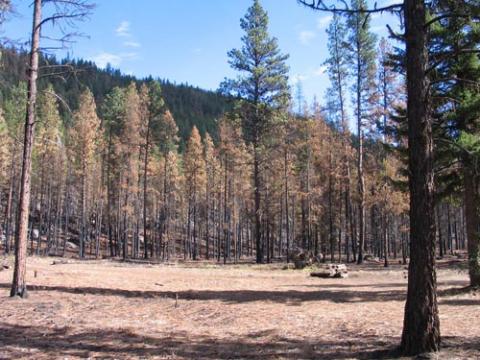Researchers have worked to assess the impacts of biomass reduction in high-risk areas such as the wildland/urban interface where treatments are intended to minimize the risk of wildfire behavior, allow for more effective suppression, and reduce severe fire effects when a wildland fire does occur. As a result, the scientific literature dealing with fuel treatment
effectiveness is growing. However, general results in the literature are quite variable, showing reduced, increased, or no effect on fire behavior and fire effects.
To better understand this variability, researchers conducted a retrospective assessment of the influence of a fuel treatment on fire behavior and effects in the Tin Cup Fire of 2007 in the Bitterroot National Forest. FFS research forester Mick Harrington and collaborator Erin Noonan-Wright collected detailed data from the 2007 fire including field sampling of stand attributes, surface/ground fuels, and fire impacts; interviews with fire fighters, including incident commander’s notes; photographs and GIS data; nearest weather station data; and internet fire data. The study, while small in scale, revealed variable results within the treated vs. untreated study area but, as significantly, led to an assessment of the types of data and other information needed to best evaluate fuel treatment influences in the future.
As a result of this review, the researchers developed the following recommendations to help reduce uncertainty concerning fuel treatment effectiveness: 1) understand weather and fire behavior in each comparative treatment; 2) discern the quality and quantity of fire suppression activity in each comparative treatment; 3) determine species composition and stand structure to understand tree mortality; and 4) distinguish surface and canopy fuels in each comparative treatment. By collecting data in all four recommendations as part of their analysis, managers can increase what is known about effective treatments. Taking such an approach can also help others make more informed decisions about when, how, or if to treat biomass accumulation in high-risk and other areas.
Photos: Fire severity was 34% tree mortality in the figure 1 photo compared to the figure 2 photo with 77% mortality.
Contrasting fire weather was the main influence of fire behavior and severity in these adjacent sites and not the fuel treatment.

